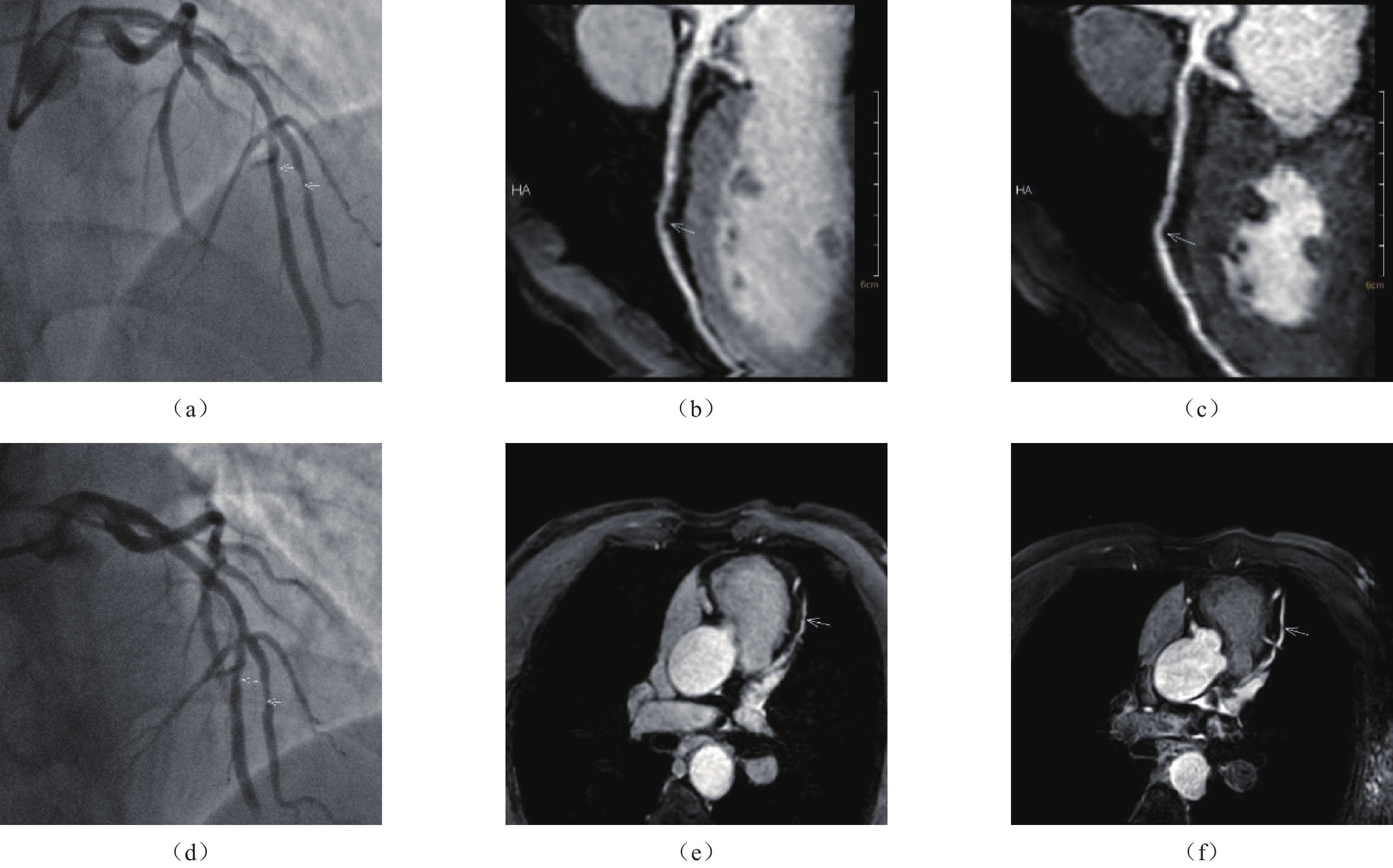Non-contrast-enhanced 3.0T Whole-heart Coronary MRA: Comparison of Diagnostic Performance between mDixon and WHCA TFE Sequence Using SPIR in CAD Using Coronary Angiography as Reference
-
摘要:
目的:对比评估mDixon水脂分离序列与全心梯度回波序列(WHCA TFE)使用SPIR压脂技术3.0T非对比增强冠状动脉磁共振成像在可疑冠心病患者中的诊断性能。方法:前瞻性研究纳入烟台毓璜顶医院自2022年9月至2023年12月45名拟行冠状动脉造影术(CAG)的患者进行非对比增强冠状动脉磁共振成像检查(NCE-CMRA)。受试者分别接受mDixon序列与3D全心TFE序列使用SPIR技术的NCE-CMRA。两位放射科医生根据主观图像质量(评分1~5,5分代表最高图像质量评分)、血管可见长度、直径以及是否存在显著狭窄来独立评估冠状动脉;以CAG结果作为参考标准。使用配对t检验比较序列间血管长度、直径的差异,Wilcoxon检验比较各节段序列间主观图像质量评分的差异,McNemar检验对比序列间敏感性、准确性、特异性的差异,联合假设检验比较阳性预测值、阴性预测值的差异。 结果:在45例可疑冠心病患者中,有40例(88.9%)成功采集了全心CMRA图像并被纳入分析,3.0T mDixon序列的总体图像质量评分为(3.9±0.9),3.0T WHCA TFE序列使用SPIR技术的总体平均图像质量评分为(3.7±0.9)。相比于WHCA TFE序列使用SPIR技术,mDixon序列在基于节段水平显示出更高的敏感度(78.5%比66.1%)、特异度(96.5%比93.8%)、准确性(91.7%比86.6%)、阳性预测值(88.6%比78.9%)以及阴性预测值(93.4%比88.7%),在基于血管水平显示出更高的敏感度(89.4%比81.6%)和准确性(89.1%比83.3%)。结论:相较于3.0T WHCA TFE序列使用SPIR技术,mDixon序列NCE-CMRA具有更可靠的诊断效能。
Abstract:Objective: To compare the diagnostic performance between mDixon sequence and WHCA TFE sequence using SPIR for non-contrast-enhanced coronary MRA in patients with suspected coronary artery disease (CAD). Method: This prospective study recruited 45 patients who were scheduled for X-ray coronary angiography (CAG) with suspected CAD in Yantai Yuhuangding hospital. Patients underwent both 3.0T WHCA TFE using SPIR and mDixon coronary MRA examinations before undergoing CAG. Two radiologists independently assessed coronary arteries in terms of subjective image quality (on a scale of 1~5, with 5 denoting the highest image quality), vessel length, vessel diameter, and presence of significant stenoses. CAG was used as the reference standard for detecting the presence of stenoses. Vessel length and diameter were compared between sequences using paired t-tests. Subjective image quality scores were compared between sequences using Wilcoxon tests. Sensitivity, specificity, and accuracy were compared between sequences using McNemar tests. Positive and negative predictive values were compared between sequences using the joint hypotheses test. Results: Two CMRA examinations were successfully performed in 40 (88.9%) of 45 patients for analysis. The objective image quality of 3.0T mDixon assessed by both radiologists was (3.9±0.9), and the 3.0T WHCA TFE using SPIR was (3.7±0.9). The mDixon sequence exhibited higher sensitivity, specificity, accuracy, positive predictive value, and negative predictive value in per-segment analysis (78.5% vs. 66.1%, 96.5% vs. 93.8%, 91.7% vs. 86.6%, 88.6% vs. 78.9%, and 93.4% vs. 88.7%) and higher sensitivity and accuracy in per-vessel analysis (89.4% vs. 81.6% and 89.1% vs. 83.3%). Conclusion: In comparison with 3.0T WHCA TFE sequence using SPIR, mDixon demonstrated superior diagnostic performance.
-
非对比增强冠状动脉磁共振成像(non-contrast-enhanced coronary magnetic resonance angiography,NCE-CMRA)是一种无需使用对比剂以及接受电离辐射的无创检测冠状动脉狭窄的检查手段[1]。对于特定的冠心病患者群体,比如肾功能不全的患者,使用冠状动脉CTA(coronary CTA,CCTA)或者冠状动脉造影术(coronary angiography,CAG)所需要的碘对比剂容易导致急性肾损伤[2-3],而使用增强的CMRA所需要的钆对比剂又会有导致肾源性全身性纤维化的风险[4],同为无创性冠状动脉狭窄检查方式,NCE-CMRA便可作为有效的替代检查方式。
3.0T NCE-CMRA由于其较高的磁场强度,相比于1.5T拥有更高的信噪比(signal-to-noise ratio,SNR)和对比噪声比(contrast-to-noise ratio,CNR),因此具有潜在更高的空间分辨率。然而高场强带来的磁场不均匀性增加会使3.0T NCE-CMRA所获取的图像质量下降[5],尤其是表现在引起基于频率的压脂技术的有效性下降方面[6],包裹冠状动脉的心外膜脂肪信号若不能得到有效抑制,则会阻碍冠状动脉解剖结构的可视化并且产生伪影,从而影响CMRA的诊断价值。随着研究进展,通过使用特定压脂技术,3.0T NCE-CMRA的图像质量逐渐提高,并且逐渐优于1.5T[7]。
频率选择饱和法压脂技术(spectral presaturation with inversion recovery,SPIR)可利用频率选择性射频脉冲仅使脂肪的磁化饱和,同时保持水的磁化从而抑制冠状动脉周围脂肪信号。其中3.0T全心冠状动脉梯度回波(whole heart coronary artery turbo-field-echo,WHCA TFE)序列可通过与压脂技术相结合提升血管信号[8],并且该序列与SPIR压脂技术结合诊断冠状动脉狭窄的可行性已被最近研究证实[9]。
mDixon是一种非平衡快速梯度回波序列,它可以基于水和脂肪在3.0T的较大化学位移抑制背景脂肪信号,从而重建出水图像用于诊断冠状动脉狭窄[10]。作为传统Dixon序列的改良,mDixon序列已经被证实在外周血管疾病以及先心病方面具有优秀的诊断能力[11-12]。根据最近研究[13],mDixon序列对于冠状动脉狭窄也具有良好的诊断准确性。然而这两种3.0T NCE-CMRA技术的诊断性能目前仍缺乏对比性研究。
本研究尝试以CAG检查结果为金标准,在3.0T NCE-CMRA上分别应用mDixon序列和WHCA TFE序列使用SPIR技术对可疑冠心病患者扫描,并将两种方法作对比,以评估其诊断表现。
1. 资料与方法
1.1 研究对象
本研究为前瞻性研究,符合《赫尔辛基宣言》。经过烟台毓璜顶医院伦理委员会批准(伦理号No.2021-453),并且每名受试者在接受检查前均签署了知情同意书。
从2022年9月到2023年12月,共纳入45例拟行CAG检查的可疑冠心病患者。排除标准:心律失常、端坐呼吸、冠状动脉支架置入或冠状动脉搭桥手术史以及具有MRI检查禁忌症。
患者在接受CMRA检查前被告知保持规律平稳并且小幅度的呼吸,检查前不服用β受体阻滞剂类药物或舌下含服硝酸甘油。
1.2 CMRA图像采集
两种不同序列的NCE-CMRA都在3.0T MR扫描仪(Philip Ingenia;Philips Healthcare)上进行,该设备配有32通道体部相控阵表面线圈。检查者进行扫描前将一条医用腹带缠绕于患者肋骨下缘以减少呼吸运动伪影[14],使用四导联心电图进行前瞻性心电门控,以及自由呼吸膈肌导航作为呼吸门控。
首先使用快速定位序列确定膈顶以及心脏位置,随后使用二维平衡稳态自由进动(two-dimensional balanced steady-state free precession,2D b-SSFP)序列扫描四腔心层面电影图像确定右冠状动脉相对静止期作为每个心动周期的固定采集时间段。随后患者使用固定采集时间段,随机顺序分别接受3.0T WHCA TFE序列和mDixon序列CMRA检查,二者均使用敏感度编码(sensitivity encoding,SENSE)作为加速采集技术。
WHCA TFE序列扫描参数:TR 4.3 ms,TE 1.7 ms,FOV 290×252×140 mm,采集矩阵180×140×90,重建矩阵374×292×220,反转角10°,SENSE 2.0×1.0,压脂技术SPIR。mDixon序列扫描参数:TR 4.5 ms,E1 1.4 ms,TE 2 2.6 ms,FOV 270×300×100 mm,采集矩阵176×201×150,重建矩阵352×400×300,SENSE 2.0×1.0。
mDixon序列获得的图像中仅水成像图被用于分析。CMRA的采集过程中记录平均心率以及门控效率。
1.3 全心CMRA图像分析
CMRA获取的原始数据均被直接传送至独立的飞利浦工作站(IntelliSpace Portal,Philips Healthcare)进行图像重建。
利用双盲法,由两名对患者CAG检查结果不知情的经验丰富的放射科医师进行图像质量评分以及显著狭窄诊断。根据美国心脏会(American Heart Association,AHA)分段法评估各个冠状动脉节段[15]。
分别测量左前降支、回旋支以及右冠状动脉长度及血管直径,其中左前降支长度测量包括左主干,血管直径在血管中段测量。两名观察者观察结果若出现差异则最后通过共识阅读获得统一结论。
主观图像质量评分采用5分法。标准:1分为不可评估,图像伪影严重,冠状动脉显示差;2分为可评估,图像伪影中等,冠状动脉显示一般;3分为可评估,图像伪影较轻,冠状动脉显示良好;4分为可评估,图像伪影轻微,冠状动脉显示好;5分为可评估,无图像伪影,冠状动脉显示十分清晰。同时,CAG可见而NCE-CMRA不可视节段也被评分为1分。
图像质量大于等于2分的节段被纳入于诊断冠状动脉显著狭窄,显著狭窄定义标准:管腔狭窄程度明显,大于血管直径的50%,管腔局限性的明显信号丢失或减低[16]。同时根据意向治疗分析,无法评估节段被纳入显著狭窄(包括评分1分以及CAG可见而NCE-CMRA不可见节段)[17]。
1.4 CAG评估
每名受检者在接受CMRA检查之后的两天内进行CAG检查。利用双盲法,由两名经验丰富的心内科医生在对CMRA结果不知情的情况下对CAG结果进行判定。根据AHA分段法评估各个冠状动脉节段[15]。
使用冠状动脉造影术定量分析软件(QCA;Siemens Healthcare)进行辅助评估,管腔狭窄程度大于50%定义为显著狭窄[16],同时若血管直径小于1.5 mm则不纳入狭窄评估。
1.5 统计分析
采用SPSS 27.0进行统计学分析。定量变量用
$(\bar{x} \pm s) $ 表示,分类变量用百分比来表示。使用配对t检验比较序列之间血管长度、血管直径的差异,使用配对Wilcoxon符号秩和检验比较各个节段的序列之间的主观图像质量评分的差异,使用Kappa分析评估两名观察者之间的一致性。以CAG为参考标准,分别在基于血管、节段水平分别评估两种CMRA序列对显著冠状动脉狭窄的诊断表现(敏感性、特异性、准确性、阳性预测值以及阴性预测值),结果包含95% CI。使用McNemar检验比较不同序列之间的敏感性、特异性、准确性,使用联合假设检验比较阳性预测值、阴性预测值,同时分别计算两种NCE-CMRA基于血管水平、节段水平的F1值。
P < 0.05认为差异有统计学意义。
2. 结果
2.1 受检者基本信息
共45例可疑冠心病患者被纳入本次实验,其中3例患者因以下原因被排除检查:心律失常(2例),冠状动脉支架置入史(1例);有1名患者由于在检查过程中呼吸模式不规则未能完成扫描;1名患者虽然成功完成CMRA扫描,但因无法耐受CAG检查未被纳入分析。
最终共40名患者完成CMRA扫描并被纳入分析,其中男性21例、女性19例,年龄41~75岁(57±10)岁;高血压23例,有吸烟史19例,有胸痛史25例;患者体质指数为(25.1±2.7),WHCA TFE平均扫描时间为(9.5±2.3)min,mDixon平均扫描时间为(8.0±2.1)min,扫描过程平均心率为(69±10)次/min,平均导航效率为(56±12)%。
2.2 NCE-CMRA的图像质量
两种NCE-CMRA中平均血管长度及血管直径见表1。mDixon序列所测得有效血管长度以及血管直径结果均优于WHCA TFE序列使用SPIR技术。
表 1 NCE-CMRA序列间血管可见长度与血管直径对比Table 1. Comparison of visible vessel length and diameters between NCE-CMRA sequencesmDixon
序列WHCA TFE
序列、SPIR
技术P 血管长度/cm 右冠状动脉 14.8±2.8 14.4±2.7 < 0.001 左前降支 13.3±1.9 13.0±1.9 < 0.001 左回旋支 10.5±1.6 10.2±1.8 < 0.001 血管直径/mm 右冠状动脉 4.2±0.6 4.1±0.6 0.002 左前降支 4.0±0.4 3.8±0.5 < 0.001 左回旋支 3.5±0.5 3.4±0.6 < 0.001 基于冠状动脉节段的图像质量评分见表2。共21个节段因直径小于1.5 mm未被纳入分析,排除这些血管节段,共499个节段被纳入分析,其中mDixon序列可见节段为495个(99.1%),WHCA TFE序列使用SPIR技术可见节段为492个(98.5%)。
表 2 NCE-CMRA序列间图像质量评分对比Table 2. Comparison of subjective image quality grades between NCE-CMRA sequences冠状动脉 mDixon
序列WHCA TFE
序列、SPIR
技术P 右冠状动脉 近段 4.3±0.7 4.2±0.8 0.035 中段 4.0±0.8 3.6±0.7 0.001 远段 3.5±0.8 3.3±0.9 0.008 后降支/后侧支 3.5±0.9 3.0±0.8 0.001 左主干 4.5±0.6 4.4±0.6 0.083 左前降支 近段 4.4±0.7 4.3±0.7 0.317 中段 4.1±0.7 3.9±0.7 0.003 远段 3.8±0.9 3.6±0.8 0.033 第1对角支 3.8±0.9 3.7±0.9 0.025 第2对角支 3.4±0.9 3.3±0.8 0.034 左回旋支 近段 4.3±0.7 4.0±0.9 0.008 远段 3.6±1.0 3.4±0.9 0.021 钝缘支 3.4±0.9 3.0±0.8 0.004 总体 3.9±0.9 3.7±0.9 0.001 两种NCE-CMRA除在左主干、左前降支近段图像质量评分没有显著差异之外,在其余血管节段的图像质量评分以及所有血管节段的整体图像质量评分mDixon序列均高于传统SPIR技术。 两名观察者之间的NCE-CMRA图像质量评分一致性良好(Kappa=0.83)。
2.3 NCE-CMRA的诊断表现
CAG结果显示,共26.1%(130/499)的节段、63.3%(76/120)的血管有显著狭窄。两个序列之间诊断性能比较汇总于表3。相较于WHCA TFE序列,mDixon序列在基于血管水平显示出更高的敏感性(89.4%比81.6%)、准确性(89.1%比83.3%);在节段水平也显示出更高的敏感性(78.5%比66.1%)、特异性(96.5%比93.8%)、准确性(91.7%比80.2%)、阳性预测值(88.6%比78.9%)以及阴性预测值(93.4%比88.7%)。
表 3 NEC-CMRA序列间诊断效能对比[%(95% CI)]Table 3. Comparison of diagnostic performance between NCE-CMRA sequences分析水平 NCE-CMRA 敏感性 P 特异性 P 准确性 P 阳性预测值 P 阴性预测值 P 基于血管 mDixon序列 89.4
(82.4~96.5)0.031 88.6
(78.9~98.4)0.5 89.1
(83.5~94.8)0.039 93.2
(87.2~99.1)0.167 82.9
(71.8~94.1)0.129 WHCA TFE序列、SPIR技术 81.6
(72.7~90.5)86.4
(75.8~96.9)83.3
(76.6~90.1)91.2
(84.3~98.1)73.1
(60.6~85.5)基于节段 mDixon序列 78.5
(71.3~85.6)0.002 96.5
(94.6~98.4)0.031 91.7
(89.3~94.2)< 0.001 88.6
(82.8~94.6)0.004 93.4
(90.1~95.3)0.006 WHCA TFE序列、SPIR技术 66.1
(57.9~74.4)93.8
(91.3~96.2)86.6
(83.6~89.6)78.9
(71.1~86.7)88.7
(85.6~91.9)同时,在基于血管水平,mDixon序列的F1值为91.3%,WHCA TFE序列使用SPIR技术为80.5%;在基于节段水平,mDixon序列的F1值为83.3%,WHCA TFE序列使用SPIR技术为71.9%。典型图像见图1。
![]() 图 1 冠状动脉造影(CAG)与全心CMRA多平面重组以及横断位图像对比图注:显示冠状动脉狭窄(↑),(a)(d)为CAG图像;(b)、(c)、(e)、(f)为CMRA图像;(a)(d)显示左前降支中段与第1对角支近段中度狭窄;(b)(c)分别为mDixon序列与WHCA TFE序列使用SPIR技术多平面重组图像第1对角支近段对应狭窄区域,mDixon序列可见中度狭窄,狭窄程度显示较TFE序列使用SPIR技术更加明显;(e)(f)分别为mDixon序列与WHCA TFE序列使用SPIR技术多平面重建图像左前降支中段对应狭窄区域。Figure 1. Comparison of coronary angiography (CAG) with whole-heart CMRA multiplanar recombination and cross-sectional images
图 1 冠状动脉造影(CAG)与全心CMRA多平面重组以及横断位图像对比图注:显示冠状动脉狭窄(↑),(a)(d)为CAG图像;(b)、(c)、(e)、(f)为CMRA图像;(a)(d)显示左前降支中段与第1对角支近段中度狭窄;(b)(c)分别为mDixon序列与WHCA TFE序列使用SPIR技术多平面重组图像第1对角支近段对应狭窄区域,mDixon序列可见中度狭窄,狭窄程度显示较TFE序列使用SPIR技术更加明显;(e)(f)分别为mDixon序列与WHCA TFE序列使用SPIR技术多平面重建图像左前降支中段对应狭窄区域。Figure 1. Comparison of coronary angiography (CAG) with whole-heart CMRA multiplanar recombination and cross-sectional images3. 讨论
本研究结果显示,相较于3.0T WHCA TFE序列使用SPIR技术,mDixon序列在使用相同图像加速采集技术的情况下,在更短的成像时间中获得了更高的中远段血管及分支血管的图像质量评分以及更长的可视血管长度,这与最近Tian等[13]的研究结果相似。同时,以CAG检查结果为金标准,mDixon序列还显示了较高的敏感性、特异性以及诊断准确性,并且相较于传统CMRA的诊断性能有显著进步[18]。
Lu等[19]实验证明,检查前服用硝酸甘油(nitroglycerin,NTG)可有效提升mDixon CMRA的诊断特异性,但NTG会诱导产生非内皮依赖性血管扩张受损,这与动脉粥样硬化和心血管意外事件的发生概率增加相关[20],并且硝酸甘油也可能会因为提高患者心率而降低图像质量,因此CMRA检查前仍需尽量避免舌下含服硝酸甘油。而本实验两种NCE-CMRA扫描均在患者未服用β受体阻滞剂或舌下含服硝酸甘油的情况下完成,并且获得了具有良好敏感性、特异性的图像,这为扩大NCE-CMRA的临床使用范围以及减少检查前的药物依赖提供了依据。
Dixon方法的压脂原理是利用水与脂肪的分子运动频率差异[21],因此无论是1.5T还是3.0T的磁场强度,都具有可靠的压脂能力。既往研究已经证明在3.0T CMRA中,Dixon序列相较于梯度回波序列使用SPIR技术可获取更好的图像质量[22],但其样本量仅为8例健康志愿者,未能研究Dixon序列的诊断性能。
本研究扩大了样本含量,并且使用了作为传统Dixon改良版本的mDixon序列,进一步证实了其相较于WHCA TFE序列使用SPIR技术更加稳健的抑脂能力和更强的冠状动脉狭窄诊断性能;此外,本研究mDixon序列所获取图像质量与可见血管长度均优于SPIR技术这一结果也与先前实验结果相一致[22]。这应该是由于呼吸运动产生的伪影不会影响mDixon的水成像图像[23],这使mDixon对呼吸运动的敏感性更低,从而在更易受运动伪影影响的中远段及分支血管水平上获取了更高图像质量评分,并且假阴性血管节段数量减少,因此诊断准确性也更高。
除了对呼吸运动伪影的低敏感性,mDixon不依赖于预饱和或反转预脉冲,这使其在3.0T或更高场强所带来的磁场不均匀性增加的情况下仍能尽量避免伪影的产生以及低对比度的情况,从而保证获取高质量的图像[22],而且在3.0T的高场强下,SPIR技术易产生空间错配现象以及对B0或B1场不均匀敏感的缺点进一步被放大,这也导致其诊断性能弱于mDixon序列。
除本实验所对比研究的两种压脂技术外,近年也有许多新兴的压脂技术被应用于NCE-CMRA。快速中断稳态(fast interrupted steady-state,FISS)序列因为其用于成像的射频脉冲(radiofrequency pulse,RF pulse)同时可以压制脂肪信号,所以具有固有的压脂能力,在成像过程中不需要周期性地施加脂肪抑制和上升脉冲,从而提升了扫描时间效率和嵌入在心外膜脂肪中的冠状动脉的可视化程度[24]。
目前已有研究证明了FISS在NCE-CMRA中应用的可行性[25]。脂质不敏感的二项式非共振射频激励法(lipid-insensitive binomial off-resonance excitation,LIBRE)是利用一种非空间选择性的水激发脉冲,该脉冲在3.0 T的高场强下显示出稳健的压脂能力[26],并且相较于传统的脂肪抑制技术,LIBRE获取了更高的NCE-CMRA图像质量[27]。但是,以上两种新兴的压脂技术均缺乏应用于冠状动脉狭窄的诊断性能研究,这仍需要多中心、多样本量的进一步研究。
此外,扫描时间长容易受患者心率及呼吸的影响,从而导致图像质量下降[28-29],本实验采用的是SENSE技术加速采集,其加速采集时间效果有限,故成像时间较长。根据最近研究[30],使用压缩感知−敏感度编码技术(compressed sensing-sensitivity encoding,CS-SENSE)与Dixon序列相结合,可以在保证图像质量、诊断表现的同时缩短采集时间。本实验mDixon序列使用SENSE技术在获得与其相似的诊断表现的同时,成像时间较长,也与该研究结果一致。
本实验的局限性。①实验参与患者具有地域集中性,且最终纳入分析样本含量较少,仅为40例。②本实验成像时间仍较长,对此可采用较先进的重建技术加速采集,如CS-SENSE技术。③冠状动脉CTA作为目前常用的无创影像学检查,其原始图像与NCE-CMRA均为横断位,并且可重建单独血管图像,两者比较可更加直观显示诊断性能差异,为进一步验证NCE-CMRA的诊断性能,还应尽量与CTA检查结果进行对比。④本实验两种CMRA的血管长度与直径均为所获取图像在飞利浦工作站进行多平面重建后进行准确测量并对比,由于CAG检查时受心脏搏动以及造影剂充盈不均等因素影响,血管长度无法准确测量,并且所测得血管直径位置并不能与CMRA准确对应,因此本实验并未进行CAG与CMRA的血管长度与直径比较,仅进行了两种NCE-CMRA间的对比。
综上所述,mDixon序列相较于WHCA TFE序列使用SPIR技术在3.0T NCE-CMRA检测冠状动脉狭窄的应用中具有更好的诊断效能。
-
图 1 冠状动脉造影(CAG)与全心CMRA多平面重组以及横断位图像对比图
注:显示冠状动脉狭窄(↑),(a)(d)为CAG图像;(b)、(c)、(e)、(f)为CMRA图像;(a)(d)显示左前降支中段与第1对角支近段中度狭窄;(b)(c)分别为mDixon序列与WHCA TFE序列使用SPIR技术多平面重组图像第1对角支近段对应狭窄区域,mDixon序列可见中度狭窄,狭窄程度显示较TFE序列使用SPIR技术更加明显;(e)(f)分别为mDixon序列与WHCA TFE序列使用SPIR技术多平面重建图像左前降支中段对应狭窄区域。
Figure 1. Comparison of coronary angiography (CAG) with whole-heart CMRA multiplanar recombination and cross-sectional images
表 1 NCE-CMRA序列间血管可见长度与血管直径对比
Table 1 Comparison of visible vessel length and diameters between NCE-CMRA sequences
mDixon
序列WHCA TFE
序列、SPIR
技术P 血管长度/cm 右冠状动脉 14.8±2.8 14.4±2.7 < 0.001 左前降支 13.3±1.9 13.0±1.9 < 0.001 左回旋支 10.5±1.6 10.2±1.8 < 0.001 血管直径/mm 右冠状动脉 4.2±0.6 4.1±0.6 0.002 左前降支 4.0±0.4 3.8±0.5 < 0.001 左回旋支 3.5±0.5 3.4±0.6 < 0.001 表 2 NCE-CMRA序列间图像质量评分对比
Table 2 Comparison of subjective image quality grades between NCE-CMRA sequences
冠状动脉 mDixon
序列WHCA TFE
序列、SPIR
技术P 右冠状动脉 近段 4.3±0.7 4.2±0.8 0.035 中段 4.0±0.8 3.6±0.7 0.001 远段 3.5±0.8 3.3±0.9 0.008 后降支/后侧支 3.5±0.9 3.0±0.8 0.001 左主干 4.5±0.6 4.4±0.6 0.083 左前降支 近段 4.4±0.7 4.3±0.7 0.317 中段 4.1±0.7 3.9±0.7 0.003 远段 3.8±0.9 3.6±0.8 0.033 第1对角支 3.8±0.9 3.7±0.9 0.025 第2对角支 3.4±0.9 3.3±0.8 0.034 左回旋支 近段 4.3±0.7 4.0±0.9 0.008 远段 3.6±1.0 3.4±0.9 0.021 钝缘支 3.4±0.9 3.0±0.8 0.004 总体 3.9±0.9 3.7±0.9 0.001 表 3 NEC-CMRA序列间诊断效能对比[%(95% CI)]
Table 3 Comparison of diagnostic performance between NCE-CMRA sequences
分析水平 NCE-CMRA 敏感性 P 特异性 P 准确性 P 阳性预测值 P 阴性预测值 P 基于血管 mDixon序列 89.4
(82.4~96.5)0.031 88.6
(78.9~98.4)0.5 89.1
(83.5~94.8)0.039 93.2
(87.2~99.1)0.167 82.9
(71.8~94.1)0.129 WHCA TFE序列、SPIR技术 81.6
(72.7~90.5)86.4
(75.8~96.9)83.3
(76.6~90.1)91.2
(84.3~98.1)73.1
(60.6~85.5)基于节段 mDixon序列 78.5
(71.3~85.6)0.002 96.5
(94.6~98.4)0.031 91.7
(89.3~94.2)< 0.001 88.6
(82.8~94.6)0.004 93.4
(90.1~95.3)0.006 WHCA TFE序列、SPIR技术 66.1
(57.9~74.4)93.8
(91.3~96.2)86.6
(83.6~89.6)78.9
(71.1~86.7)88.7
(85.6~91.9) -
[1] MANNING W J, LI W, EDELMAN R R. A preliminary report comparing magnetic resonance coronary angiography with conventional angiography[J]. The New England Journal of Medicine, 1993, 328(12): 828-832. DOI: 10.1056/NEJM199303253281202.
[2] MOLEN A J, REIMER P, DEKKERS I A, et al. Post-contrast acute kidney injury-Part 2: Risk stratification, role of hydration and other prophylactic measures, patients taking metforminand chronic dialysis patients: Recommendations for updated ESUR Contrast Medium Safety Committee guidelines[J]. European Radiology, 2018, 28(7): 2856-2869. DOI: 10.1007/s00330-017-5247-4.
[3] MOLEN A J, REIMER P, DEKKERS I A, et al. Post-contrast acute kidney injury-Part 1: Definition, clinical features, incidence, role of contrast medium and risk factors: Recommendations for updated ESUR Contrast Medium Safety Committee guidelines[J]. European Radiology, 2018, 28(7): 2845-2855. DOI: 10.1007/s00330-017-5246-5.
[4] HE A, KWATRA S G, ZAMPELLA J G, et al. Nephrogenic systemic fibrosis: Fibrotic plaques and contracture following exposure to gadolinium-based contrast media[D]. BMJ Case Reports, 2016.
[5] BI X, DESHPANDE V, SIMONETTI O, et al. Three-dimensional breathhold SSFP coronary MRA: A comparison between 1.5T and 3.0T[J]. Journal of Magnetic Resonance Imaging, 2005, 22(2): 206-212. DOI: 10.1002/jmri.20374.
[6] SIMON J H, SZUMOWSKI J. Proton (fat/water) chemical shift imaging in medical magnetic resonance imaging: Current status[J]. Investigative Radiology, 1992, 27(10): 865-874. DOI: 10.1097/00004424-199210000-00018.
[7] KAUL M G, STORK A, BANSMANN P M, et al. Evaluation of balanced steady-state free precession (TrueFISP) and K-space segmented gradient echo sequences for 3D coronary MR angiography with navigator gating at 3 Tesla[J]. Rofo, 2004, 176(11): 1560-1565. DOI: 10.1055/s-2004-813629.
[8] KAWADA H, GOSHIMA S, SAKURAI K, et al. Utility of noncontrast magnetic resonance angiography for aneurysm follow-up and detection of endoleaks after endovascular aortic repair[J]. Korean Journal of Radiology, 2021, 22(4): 513-524. DOI: 10.3348/kjr.2020.0001.
[9] CHEN Y, GUO H, DONG P, et al. Feasibility of 3.0T balanced fast field echo non-contrast-enhanced whole-heart coronary magnetic resonance angiography[J]. Cardiovascular Diagnosis and Therapy, 2023, 13(1): 51-60. DOI: 10.21037/cdt-22-487.
[10] EGGERS H, BRENDEL B, DUIJNDAM A, et al. Dual-echo Dixon imaging with flexible choice of echo times[J]. Magnetic Resonance in Medicine, 2011, 65(1): 96-107. DOI: 10.1002/mrm.22578.
[11] KOURTIDOU S, JONES M R, MOORE R A, et al. mDixon ECG-gated 3-dimensional cardiovascular magnetic resonance angiography in patients with congenital cardiovascular disease[J]. Journal of Cardiovascular Magnetic Resonance, 2019, 21(1): 52. DOI: 10.1186/s12968-019-0554-3.
[12] WEISS K J, EGGERS H, STEHNING C, et al. Feasibility and robustness of 3T magnetic resonance angiography using modified dixon fat suppression in patients with known or suspected peripheral artery disease[J]. Frontiers in Cardiovascular Medicine, 2020, 7: 549392. DOI: 10.3389/fcvm.2020.549392.
[13] TIAN D, ZHAO S H, WANG Y, et al. Unenhanced whole-heart coronary MRA: Prospective intraindividual comparison of 1.5-T SSFP and 3-T Dixon water-fat separation gre methods using coronary angiography as reference[J]. American Journal of Roentgenology, 2022, 219(2): 199-211. DOI: 10.2214/AJR.21.27292.
[14] BECKER H, WATTENBERG M, BARTH P, et al. Impact of different respiratory monitoring techniques on respiration-dependent stroke-volume measurements assessed by real-time magnetic resonance imaging[J]. Zeitschrift Für Medizinische Physik, 2019, 29(4): 349-358.
[15] AUSTEN W G, EDWARDS J E, FRYE R L, et al. A reporting system on patients evaluated for coronary artery disease. Report of the AD HOC committee for grading of coronary artery disease, council on cardiovascular surgery[J]. American Heart Association. Circulation, 1975, 51(S4): 5-40.
[16] DUERINCKX A J, URMAN M K. Two-dimensional coronary MR angiography: Analysis of initial clinical results[J]. Radiology, 1994, 193(3): 731-738. DOI: 10.1148/radiology.193.3.7972815.
[17] YANG Q, LI K, LIU X, et al. Contrast-enhanced whole-heart coronary magnetic resonance angiography at 3.0-T: A comparative study with X-ray angiography in a single center[J]. Journal of the American College of Cardiology, 2009, 54(1): 69-76. DOI: 10.1016/j.jacc.2009.03.016.
[18] 周妙平, 张兆琪, 于薇, 等. 3.0T非增强全心冠状动脉MR成像评价冠状动脉狭窄的初步研究[J]. 中华放射学杂志, 2013, 47(10): 883-888. DOI: 10.3760/cma.j.issn.1005-1201.2013.10.004. ZHOU M P, ZHANG Z Q, YU W, et al. Preliminary study on non-contrast-enhanced whole-heart coronary magnetic resonance angiography at 3.0T to evaluate the coronary stenosis[J]. Chinese Journal of Radiology, 2013, 47(10): 883-888. DOI: 10.3760/cma.j.issn.1005-1201.2013.10.004. (in Chinese).
[19] LU H, ZHAO S, TIAN D, et al. Clinical application of non-contrast-enhanced dixon water-fat separation compressed sense whole-heart coronary MR angiography at 3.0T with and without nitroglycerin[J]. Journal of Magnetic Resonance Imaging, 2022, 55(2): 579-591. DOI: 10.1002/jmri.27829.
[20] SCHACHINGER V, BRITTEN M B, ZEIHER A M. Prognostic impact of coronary vasodilator dysfunction on adverse long-term outcome of coronary heart disease[J]. Circulation, 2000, 101(16): 1899-1906.
[21] DIXON W T. Simple proton spectroscopic imaging[J]. Radiology, 1984, 153(1): 189-194.
[22] NEZAFAT M, HENNINGSSON M, RIPLEY D P, et al. Coronary MR angiography at 3T: Fat suppression versus water-fat separation[J]. Magma, 2016, 29(5): 733-738. DOI: 10.1007/s10334-016-0550-7.
[23] BORNERT P, KOKEN P, NEHRKE K, et al. Water/fat-resolved whole-heart Dixon coronary MRA: An initial comparison[J]. Magnetic Resonance in Medicine, 2014, 71(1): 156-163. DOI: 10.1002/mrm.24648.
[24] KOKTZOGLOU I, EDELMAN R R. Radial fast interrupted steady-state (FISS) magnetic resonance imaging[J]. Magnetic Resonance in Medicine, 2018, 79(4): 2077-2086. DOI: 10.1002/mrm.26881.
[25] BASTIAANSEN J, PICCINI D, DI S L, et al. Natively fat-suppressed 5D whole-heart MRI with a radial free-running fast-interrupted steady-state (FISS) sequence at 1.5T and 3T[J]. Magnetic Resonance in Medicine, 2020, 83(1): 45-55. DOI: 10.1002/mrm.27942.
[26] BASTIAANSEN J, STUBER M. Flexible water excitation for fat-free MRI at 3T using lipid insensitive binomial off-resonant RF excitation (LIBRE) pulses[J]. Magnetic Resonance in Medicine, 2018, 79(6): 3007-3017. DOI: 10.1002/mrm.26965.
[27] BASTIAANSEN J, Van HEESWIJK R B, STUBER M, et al. Noncontrast free-breathing respiratory self-navigated coronary artery cardiovascular magnetic resonance angiography at 3T using lipid insensitive binomial off-resonant excitation (LIBRE)[J]. Journal of Cardiovascular Magnetic Resonance, 2019, 21(1): 38. DOI: 10.1186/s12968-019-0543-6.
[28] 于兵, 孙红彬, 侯阳, 等. 心率变异率对3.0T磁共振自由呼吸全心冠状动脉成像图像质量的影响[J]. 中国医学影像技术, 2010, 26(2): 282-284. YU B, SUN H B, HOU Y, et al. Effect of heart rate variability on image quality of 3D free-breathing whole-heart coronary MR angiography with 3.0T scanner[J]. Chinese Journal of Medical Imaging Technology, 2010, 26(2): 282-284. (in Chinese).
[29] 戴沁怡, 贺毅, 张兆琪, 等. 全心冠状动脉MR成像的图像质量及其影响因素[J]. 中国医学影像技术, 2013, 29(2): 293-297. DAI X Y, HE Y, ZHANG Z Q, et al. Image quality and impact factors of whole-heart coronary MR angiography[J]. Chinese Journal of Medical Imaging Technology, 2013, 29(2): 293-297. (in Chinese).
[30] 鲁鸿飞, 田地, 赵士海, 等. 3.0T非增强Dixon水脂分离压缩感知冠状动脉MR血管成像诊断冠状动脉狭窄的效能研究[J]. 中华放射学杂志, 2022, 56(10): 1051-1057. DOI: 10.3760/cma.j.cn112149-20211227-01152. LU H F, TIAN D, ZHAO S H, et al. A study on diagnostic performance of 3.0T non-contrast-enhanced dixon water-fat separation compressed SENSE whole-heart coronary MR angiography[J]. Chinese Journal of Radiology, 2022, 56(10): 1051-1057. DOI: 10.3760/cma.j.cn112149-20211227-01152. (in Chinese).




 下载:
下载:



